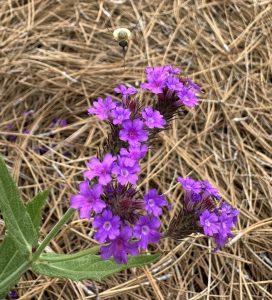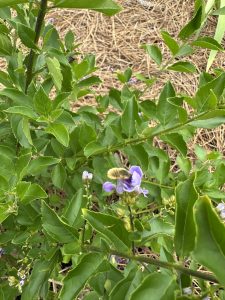When I walk around the garden every day I take a little inventory of how things are growing, what is flowering, and am always on the lookout for new bugs I haven’t seen before. This past week I was pleasantly surprised by what at first I thought was a bee with a long mouthpart (proboscis), but soon realized it was not a bee at all!
This small, flying insect buzzed up to purple flowers on several plants in my garden. The body was covered in golden hairs with some black showing through giving it that distinctive bee look. The proboscis was so long in proportion to the rest of the insect that it reminded me of the beak on a hummingbird. Still thinking it was a bee of some kind I started trying to get a picture and that is when I saw the telltale antennae and eyes that clued me in that this was not a bee at all, but rather some type of fly.
So, what was this strange looking insect? It is a bee mimic commonly called a bee fly (Bombylius spp.). The bee fly not only looks like a bee, but it takes advantage of native bees to support its young. The female bee fly watches where a ground dwelling solitary bee makes her nest and as she forages for pollen to feed her young the bee fly drops an egg nearby. After hatching the bee fly larva makes its way into the real bee’s nesting chamber and eats the pollen provisions then eats the bee larva. Since solitary ground dwelling bees tend to aggregate in similar suitable locations, I can only guess that the bee fly’s clever disguise prevents it from drawing attention as a threat to the hardworking bee.
For more information about bee flies visit https://www.fs.usda.gov/wildflowers/pollinators/pollinator-of-the-month/bee_flies.shtml
- Thinking of Starting a Cut Flower Business? Don’t miss out on Cut Flower 101! - October 30, 2025
- 2025 Gardening in the Panhandle LIVE! Great Southeast Pollinator Census – Bee a Citizen Scientist! Wrap Up - September 18, 2025
- Will you Bee a Citizen Scientist? - August 15, 2025


